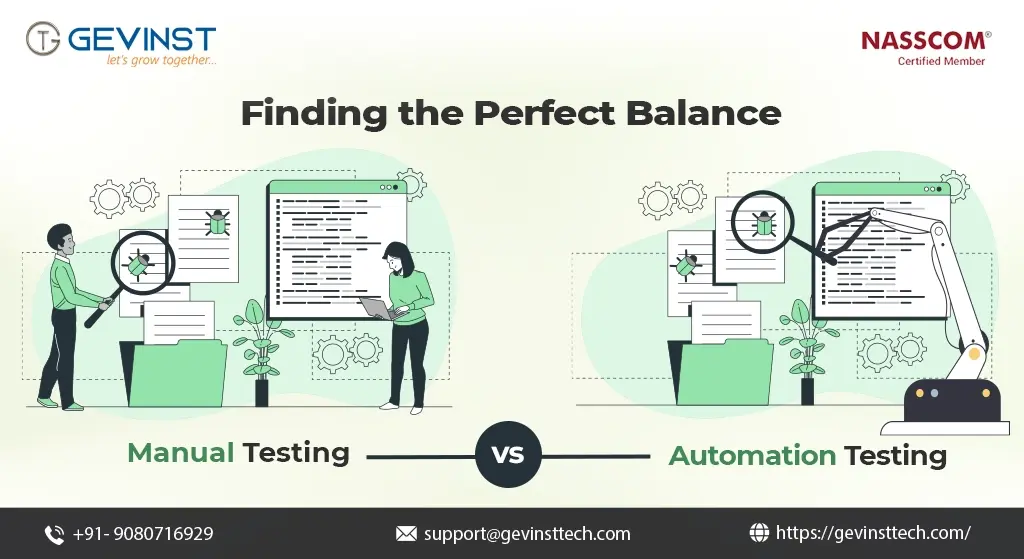
Manual vs. Automation Testing: Finding the Perfect Balance
You’re building a new software application, destined to be the next big thing in the industry. Your customers expect a flawless experience, free from bugs and glitches. How do you ensure this?
Here’s where the testing comes in, with two main approaches: Manual Testing and Automation Testing. In this article, we’ll tackle the importance of both, their limitations, and how finding the perfect balance can lead to software of excellence.
What is Manual Testing?
Manual testing, as the name suggests, involves human testers manually executing test cases without the assistance of automation tools. It’s a hands-on approach that relies on the tester’s intuition, experience, and attention to detail.
Why is it Needed?
| Technique | Description |
|---|---|
| Understanding User Experience | Manual testing allows testers to simulate real user interactions, catching usability issues that automated tests might miss. |
| Exploratory Testing | Testers can explore the software in an unscripted manner, uncovering unexpected bugs and issues. |
| Effective Regression Testing | Especially useful for smaller projects or specific functionalities, where writing automation scripts might be time-consuming. |
Manual Testing Concepts and Process
| Topic | Description |
|---|---|
| Test Cases | Detailed steps that a tester follows to validate a particular feature or functionality. |
| Regression Testing | Verifying that recent code changes haven’t adversely affected existing functionalities. |
| Tools for Manual Testing | Various tools are available for test case management, bug tracking, and more. |
How is Manual Testing Involved in Web and Mobile Applications?
Web App Development
Manual testing in web apps involves checking for cross-browser compatibility, responsive design across devices, functionality across different operating systems, and ensuring secure data transmission.
Mobile App Development
In mobile apps, manual testing includes checking for various screen resolutions, device-specific functionalities (like GPS and cameras), compatibility with different OS versions, and usability on touch interfaces.
Importance of Manual Testing
| Advantage | Description |
|---|---|
| Human Touch | Nothing beats the critical thinking and intuition of a human tester when it comes to spotting unusual behavior or edge cases. |
| Initial Testing | Ideal for early stages of development when features are evolving rapidly, allowing for quick feedback and adjustments. |
| Cost-Effective | For small-scale projects or specific functionalities, manual testing can be more cost-effective than setting up and maintaining automation frameworks. |
Limitations of Manual Testing
| Disadvantage | Description |
|---|---|
| Time-Consuming | Executing repetitive test cases manually can be time-intensive and prone to errors. |
| Resource Intensive | Requires experienced testers, which might not be feasible for all projects. |
| Not Scalable | Difficult to replicate tests across various environments or configurations without automation. |
What is Automation Testing?
Automation testing involves utilizing specialized software tools to execute pre-scripted tests on the software. It’s efficient, repeatable, and great for regression testing, performance testing, and scenarios with large datasets.
Why is it Needed?
| Advantage | Description |
|---|---|
| Speed and Efficiency | Automated tests can run much faster than manual tests, especially when dealing with large volumes of test cases. |
| Repeatability | Ensures that the same tests are carried out consistently, reducing the possibility of human error. |
| Regression Testing Made Easy | Perfect for running regression tests after each code change, ensuring no unintended consequences. |
Automation Testing Concepts and Process
| Step | Description |
|---|---|
| Test Planning | Define the scope, objectives, and approach for automation. |
| Tool Selection | Choose the appropriate automation tool based on project requirements. |
| Test Script Development | Create test scripts to automate the test scenarios. |
| Execution | Run the automated tests using the selected tool. |
| Analysis and Reporting | Analyze test results and generate reports for stakeholders. |
| Maintenance | Update test scripts as needed to reflect changes in the application. |
How is Automation Testing Involved in Web and Mobile Applications?
Web App Development
Automation testing in web apps helps in the continuous testing of dynamic elements, load testing, performance testing, and regression testing of frequently changing code.
Mobile App Development
In mobile apps, automation testing ensures smooth functionality across various devices, OS versions, and automates repetitive tasks such as login/logout, data entry, and validation.
Importance of Automation Testing
| Benefit | Description |
|---|---|
| Efficiency Enhancement | Runs tests rapidly in parallel, accelerating development for faster, quality releases. |
| Rock-Solid Reliability | Eliminates variability, ensuring precise results vital for rigorous testing. |
| Early Bug Detection | Identifies defects quickly, saving costs and enhancing software stability. |
| Long-Term Cost-Effective Testing | Reduces manual effort, leading to significant long-term savings. |
| Seamless CI/CD Integration | Automated tests with each commit, preventing regressions seamlessly. |
| Improved Quality | Delivers above the line software, building user trust and competitive advantage. |
Limitations of Automation Testing
| Challenge | Description |
|---|---|
| Initial Investment | Setting up automation frameworks and scripts requires time and resources. |
| Maintenance Effort | Test scripts need regular updates to match changes in the application. |
| Resource Requirements | To design and maintain automation scripts, testers must be proficient in programming. |
| Tool Selection | Choosing the right automation tool for the project can be challenging. |
| Not Suitable for All Tests | Some tests, such as usability testing or exploratory testing, are better suited for manual execution. |
Finding the Balance
So, which approach is better: Manual or Automation Testing? The answer lies in finding the perfect balance for your project. How do you conclude? By Considering:
| Consideration | Description |
|---|---|
| Complex Features | Consider automation for repetitive tasks, data-driven testing, and scenarios requiring multiple configurations. |
| Early Stages | Start with manual testing to quickly catch usability issues, if necessary, then automate as the project stabilizes. |
| Resource Availability | Evaluate the expertise of your team and project requirements to decide the optimal mix. |
Quick Contrast
| Aspect | Manual Testing | Automation Testing |
|---|---|---|
| Process | Test cases executed manually by human testers | Test scripts executed automatically by tools |
| Execution Speed | Slower due to manual intervention. | Faster due to automation tools |
| Human Interaction | Tester mimics real user actions | No human intervention during test execution |
| Initial Setup Time | Quick setup without scripting required | Requires time for script development initially |
| Exploratory Testing | Ideal for exploratory and ad-hoc testing | Not suitable for exploratory testing |
| Cost and Resources | More resources needed for manual execution | Requires skilled resources for script creation |
| Regression Testing | Time-consuming for large-scale projects | Quick and efficient for regression scenarios |
| Adaptability | Easily adaptable to changing requirements | Requires script maintenance for changes |
| Usability Testing | Effective for assessing user experience | Limited usability testing capabilities |
| Suitability | Best for smaller projects or one-time tests | Ideal for large-scale, repetitive scenarios |
| Tools Usage | Minimal reliance on automation tools | Relies heavily on automation testing tools |
Quick flow in Testing
| Practice | Description |
|---|---|
| Regression Testing | Crucial for catching unintended bugs after changes. |
| Manual Testing | Essential for early feedback and understanding user needs. |
| Tools for Testing | Choose thoughtfully, depending on project needs and team competence. |
Balancing Manual and Automation Testing
Manual and automation testing are equally important in the sector of software development. While manual testing offers the human touch and quick adaptability, automation testing provides speed, repeatability, and efficiency. By understanding their importance, limitations, and using the right mix, you can ensure top-build software quality that delights your users.
Embrace the best of both Manual and Automation testing to unlock seamless quality assurance for your project with Gevinst Technologies. Partner with us today for perfect testing options that uplift your software’s performance and reliability.







1,611 Comments